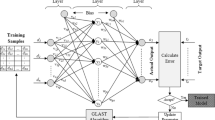Abstract
At present days, world is facing several issues like irregular distribution of medicinal resources, new chronic diseases, and the raising operating cost. The way of combining recent technologies into the medical system will helps to significantly resolve the problems. This study introduces a big health application system based on optimal artificial neural network (OANN) for heart disease diagnosis, which is considered as a deadliest disease in all over the globe. The proposed OANN includes a set of two main processes namely, distance based misclassified instance removal (DBMIR) and teaching and learning based optimization (TLBO) algorithm for ANN, called (TLBO-ANN). The proposed model is developed using a Big Data framework like Apache Spark. The presented OANN model operates on two phases, namely offline prediction and online prediction. During the offline prediction stage, the benchmark heart disease dataset will be used to train a model and performs testing. Similarly, at the online prediction stage, the real time data will be streamed into Apache Spark model and the filtered data will be diagnosed by the use of trained model to obtain the prediction results. The performance of the presented OANN model has been tested using a benchmark heart disease dataset from UCI repository. A comprehensive experimental result analysis clearly verified the better outcome of the OANN model over the compared methods. The proposed method is found to be an effective tool to analyze big data based heart disease prediction model to satisfy the need of increasing number of heart patients.







Similar content being viewed by others
Change history
06 June 2022
This article has been retracted. Please see the Retraction Notice for more detail: https://doi.org/10.1007/s12652-022-04077-4
References
Ahmed H, Younis EM, Hendawi A, Ali AA (2019) Heart disease identification from patients’ social posts, machine learning solution on Spark. Fut Generat Comput Syst. https://doi.org/10.1016/j.future.2019.09.056
Amin MS, Chiam YK, Varathan KD (2019) Identification of significant features and data mining techniques in predicting heart disease. Telemat Inform 36:82–93
Bursen K, Kirar VPS, Burse A, Burse R (2019) Various preprocessing methods for neural network based heart disease prediction. In: Tiwari S, Trivedi M, Mishra K, Misra A, Kumar K (eds) Smart innovations in communication and computational sciences. Springer, Singapore, pp 55–65
Chen M (2014) NDNC-BAN: supporting rich media healthcare services via named data networking in cloud-assisted wireless body area networks. Inf Sci 284:142–156
Chen M, Gonzalez S, Leung V, Zhang Q, Li M (2010) A 2G-RFID-based e-healthcare system. IEEE Wirel Commun 17(1):37–43
Chen M, Mao S, Zhang Y, Leung VC (2014a) Big data: related technologies, challenges and future prospects, pp 1–3
Chen M, Mao S, Liu Y (2014b) Big data: a survey. Mob Netw Appl 19(2):171–209
Desai SD, Giraddi S, Narayankar P, Pudakalakatti NR, Sulegaon S (2019) Back-propagation neural network versus logistic regression in heart disease classification. In: Mandal J, Bhattacharyya D, Auluck N (eds) Advanced computing and communication technologies. Springer, Singapore, pp 133–144
Enriko IKA, Suryanegara M, Gunawan D (2016) Heart disease prediction system using k-nearest neighbor algorithm with simplified patient’s health parameters. J Telecommun Electron Comput Eng 8(12):59–65
Fang W (2019) Analysis of BP neural network model with human-autonomous devices for school physical education management. J Ambient Intell Hum Comput. https://doi.org/10.1007/s12652-019-01477-x
Foschini L, Taleb T, Corradi A, Bottazzi D (2011) M2M-based metropolitan platform for IMS-enabled road traffic management in IoT. IEEE Commun Mag 49(11):50–57
Gambhir S, Malik SK, Kumar Y (2017) PSO-ANN based diagnostic model for the early detection of dengue disease. New Horizons Transl Med 4(1–4):1–8
Liu Q, Ma Y, Alhussein M, Zhang Y, Peng L (2016) Green data center with IoT sensing and cloud-assisted smart temperature control system. Comput Netw 101:104–112
Ma YJ, Zhang Y, Dung OM, Li R, Zhang DQ (2015) Health internet of things: recent applications and outlook. J Internet Technol 16(2):351–362
Manogaran G, Varatharajan R, Priyan MK (2018) Hybrid recommendation system for heart disease diagnosis based on multiple kernel learning with adaptive neuro-fuzzy inference system. Multim Tools Appl 77(4):4379–4399
Nazari S, Fallah M, Kazemipoor H, Salehipour A (2018) A fuzzy inference-fuzzy analytic hierarchy process-based clinical decision support system for diagnosis of heart diseases. Expert Syst Appl 95:261–271
Perera C, Liu CH, Jayawardena S, Chen M (2014) A survey on internet of things from industrial market perspective. IEEE Access 2:1660–1679
Rao RV, Savsani VJ, Vakharia DP (2011) Teaching–learning-based optimization: a novel method for constrained mechanical design optimization problems. Comput Aided Des 43(3):303–315
Suto J, Oniga S (2018) Efficiency investigation of artificial neural networks in human activity recognition. J Ambient Intell Hum Comput 9(4):1049–1060
Tian D, Zhou J, Wang Y, Lu Y, Xia H, Yi Z (2015) A dynamic and self-adaptive network selection method for multimode communications in heterogeneous vehicular telematics. IEEE Trans Intell Transp Syst 16(6):3033–3049
Tian D, Zhou J, Wang Y, Zhang G, Xia H (2016a) An adaptive vehicular epidemic routing method based on attractor selection model. Ad Hoc Netw 36:465–481
Tian D, Zhou J, Sheng Z, Leung VC (2016b) Robust energy-efficient MIMO transmission for cognitive vehicular networks. IEEE Trans Veh Technol 65(6):3845–3859
Venkatesan C, Karthigaikumar P, Paul A, Satheeskumaran S, Kumar RJIA (2018) ECG signal preprocessing and SVM classifier-based abnormality detection in remote healthcare applications. IEEE Access 6:9767–9773
Zhang Y, Chen M, Mao S, Hu L, Leung VC (2014) CAP: community activity prediction based on big data analysis. IEEE Netw 28(4):52–57
Zhang Y, Qiu M, Tsai CW, Hassan MM, Alamri A (2015) Health-CPS: healthcare cyber-physical system assisted by cloud and big data. IEEE Syst J 11(1):88–95
Author information
Authors and Affiliations
Corresponding author
Additional information
Publisher's Note
Springer Nature remains neutral with regard to jurisdictional claims in published maps and institutional affiliations.
This article has been retracted. Please seethe retraction notice for more detail: https://doi.org/10.1007/s12652-022-04077-4
About this article
Cite this article
Thanga Selvi, R., Muthulakshmi, I. RETRACTED ARTICLE: An optimal artificial neural network based big data application for heart disease diagnosis and classification model. J Ambient Intell Human Comput 12, 6129–6139 (2021). https://doi.org/10.1007/s12652-020-02181-x
Received:
Accepted:
Published:
Issue Date:
DOI: https://doi.org/10.1007/s12652-020-02181-x




